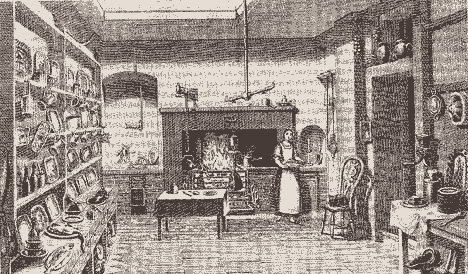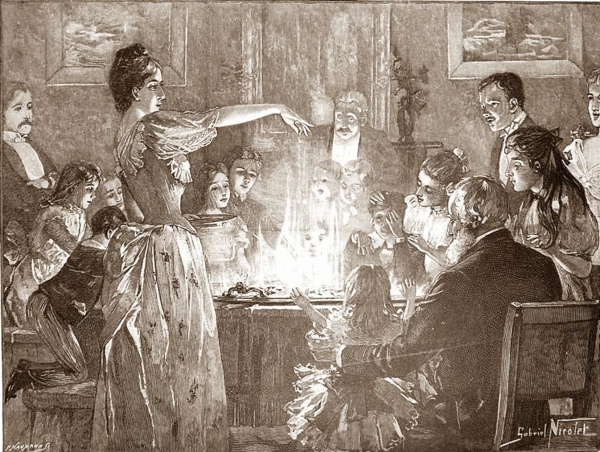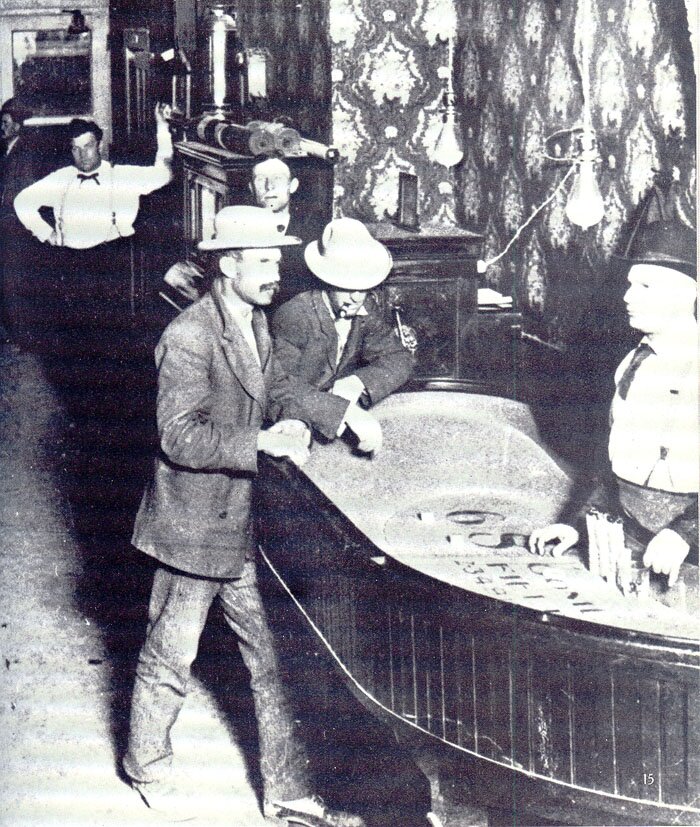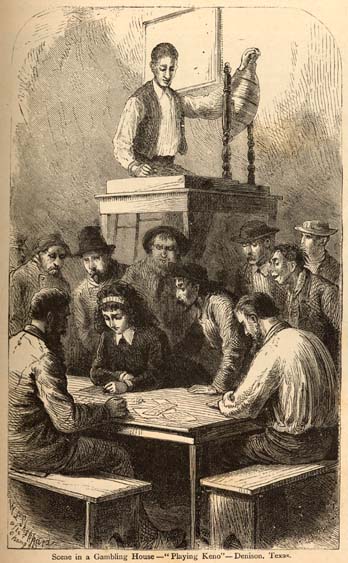source: Inside the Victorian Home, Judith Flanders, 2003
Remember
that in the 19th Century, rooms were ideally single-purpose; thus, the proper
Victorian home would have had a kitchen for cooking only, with separate rooms
for food storage (the larder) and preparation (the scullery). Of course, as
with today's kitchens, the truth was that not many homes could afford an
"ideal" kitchen, and the room was used for a wide range of functions.
In many homes, the kitchen actually had to serve as a bedroom for one of the
servants.
In the
ideal kitchen, a scullery (no matter how small) was attached, with one, or even
two sinks for cleaning food and washing and pots. A separate pantry for storing
china and glass (and silver if there was any) might be as small as a closet. It
typically had a small sink for washing dishes, of wood lined with lead to
prevent chipping. The larder for fresh food storage might only be a large
cupboard, and the storeroom for dried goods and cleaning equipment might be
another.
By the
middle of the century, most middle-class homes did have running water, but it
was expensive, nearly 10 % of the cost of the rent of the home, according to
some estimates. The kitchen was usually the first to be connected to the city
water supply, but by the 1870's, many middle-class homes had bathrooms with
running water (heated on the kitchen range) and flush toilets as well. Our Homes in 1883 estimated that the
average person needed twenty-two gallons of water a day, divided as follows:
Domestic
usage, excluding laundry 9
gallons
Toilets 5
gallons
Baths
- one per week 5
gallons
Washing
clothes 3
gallons
The kitchen
was typically located below ground, or on the lowest floor of the house. As it
supplied the hot water for the entire premises, the kitchen stove "blasted
out heat all the year round for up to eighteen hours a day." Conditions
inside the room were far from pleasant, with the gas burning all day and (at
best) only a small window near the ceiling to remove the fumes. Floors were usually covered in linoleum, for
ease of cleaning. This was often laid over a cement base in order to keep
vermin away.
"The
labor, steam and dirt all centered around the kitchen range," fueled by
coal fire. These came into common use by the 1840's. Before that time, baked
items must be taken to a communal bakehouse for preparation. There were many
styles of ranges, but the main features were a boiler to heat water and an oven
(or ovens). By the 1860's, "improved" ranges had hot plates to keep
soups simmering, keep hot dishes warm, and even to heat irons. They had a
roaster with movable shelves, which could be converted from an open to a closed
oven by moving valves. One of the main advantages of the range was that soot no
longer fell into the food in the oven (although it still might come down the
chimney and fall into the saucepans). Soot in food remained a common problem,
especially as there was no temperature controls on the range as the modern
stove has.
Another
common problem in the kitchen was waste. Thrift was a Victorian virtue, and
every good housewife made certain that anything which could be reused would be.
Of course, modern packaging had yet to be invented, so there was less to
dispose of in that area - goods either arrived unwrapped, or wrapped in simple
paper, which could be reused or burned if soiled. One reuse was as lavatory
paper.
One system
which has vanished in the modern day was the collection of different waste by
street traders who would regularly visit the back door of the home to buy
various items: paper, metals, wood, even empty bottles. "Old textiles and
bones were bought by the rag-and-bone man, who sold his wares to paper mills
and to glue, gelatin, match, toothpick, and fertilizer manufacturers."
Within the
kitchen, the range must be large enough to cook meals for the family, which
might contain a dozen people with the servants included. The Modern Householder in 1872 also listed the following
necessities for "Cheap Kitchen Furniture:" an open range, fender, fire irons; 1 deal table; bracket of deal to be
fastened to the wall and let down when wanted; wooden chair; floor canvas;
coarse canvas to lay before the fire when cooking; wooden tub for washing glass
and china; large earthenware pan for washing plates; small zinc basin for
washing hands; 2 washing-tubs; clothesline; clothes horse; yellow bowl for
mixing dough; wooden salt-box to hang up; small coffee mill; plate rack;
knife-board; large brown earthenware pan for bread; small wooden flour kit; 3
flat irons; an Italian iron, and iron stand; old blanket for ironing on; 2 tin
candlesticks, snuffers, extinguishers; 2 blacking brushes; 1 scrubbing brush; 1
carpet broom; 1 short-handled broom; cinder-sifter, dustpan, sieve, bucket;
patent digester; tea kettle; toasting fork; bread grater; bottle jack (a screen
can be made with the clothes-horse covered with sheets); set of skewers; meat
chopper; block-tin butter saucepan; colander; 3 iron saucepans; 1 iron boiling
pot; 1 fish kettle; 1 flour dredger; 1 frying pan; 1 hanging gridiron; salt and
pepper boxes; rolling pin and pasteboard; 12 patty pans; 1 larger tin pan; pair
of scales; baking dish.
Mrs. Mary
Haweis gave "a useful little kitchen list for a very small household"
which gave 109 items, not including cutlery or dishes! Among the brushes she
thought indispensable were sets of stove brushes, boot brushes and scrub
brushes, a bass (fiber) brush, a hair broom, a carpet broom, a sweep's broom,
and a broom for the banisters -- none of which could serve any other purpose.
The important thing for the Victorian home was to have the proper tools for
cleanliness.
The kitchen range
must also be cleaned thoroughly and carefully, or the heated metal would spread
the scent of scorched fat and burning food throughout the house. To clean a
range, the fender and fire irons were first removed, then damp tea leaves were
scattered over the coal to keep the dust down while cleaning was in progress.
The ashes and cinders were raked out and separated, with the unusable ash saved
for the dustman and the cinders reused in the fire. The flues were then cleaned
and the grease scraped off the stove. The steel part was cleaned with bathbrick
(powdered brick used as an abrasive) and paraffin, and the iron parts were blackleaded
and polished. In a house with only one or two servants, the oven was swept and
the blackleading applied only to the bars and front every day, and the rest was
cleaned twice a week. If there were more servants, the entire process was
repeated daily, including scraping out the oven and rinsing it with vinegar and
water.
Cleanliness
was indeed next to godliness in the eyes of the Victorian citizen, and most of
the cleaning was done in the scullery, companion to the kitchen and next up in
our look Inside the Victorian Home.





















